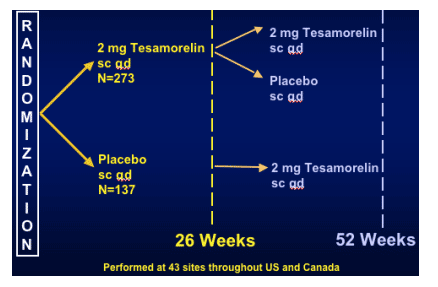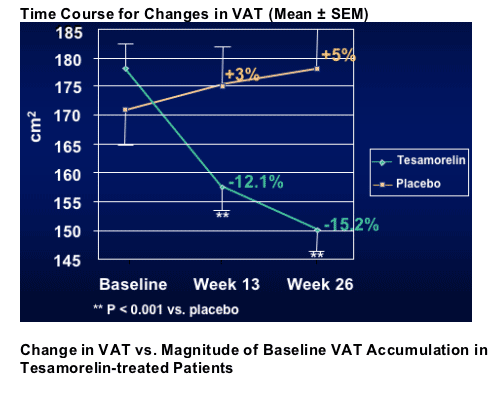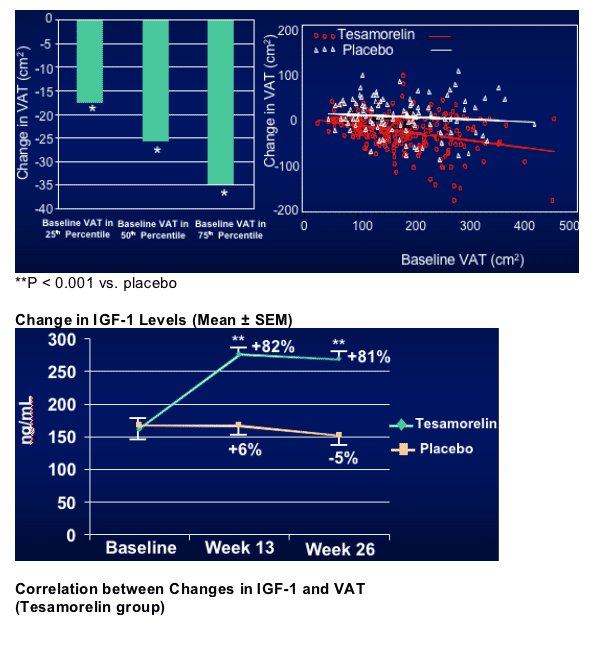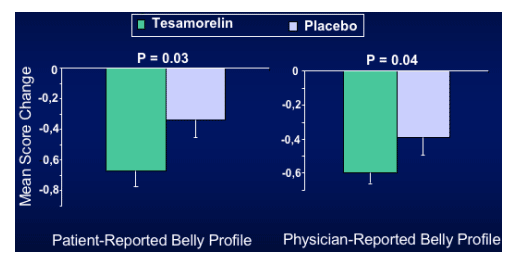 |
 |
 |
| |
TH9507, Growth Hormone Releasing Factor
|
| |
| |
Reported by Jules Levin
9th Intl Workshop on Adverse Drug Reactions and Lipodystrophy in HIV
Sydney, Australia, July 19-21 2007
Further Data on the Effects of Tesamorelin (TH9507), a Growth Hormone-Releasing Factor (GRF) Analogue, on Body Composition and Metabolic Parameters in HIV-Infected Patients with Abdominal Fat Accumulation
Julian Falutz1, Soraya Allas2, Jean-Claude Mamputu2, Diane Potvin2, Donald Kotler3, and Steven Grinspoon*4
Montreal General Hospital, McGill University Health Center1~ Theratechnologies, Inc., Montreal, Canada2~ St. Lukes Roosevelt Hospital Center, Columbia University College of Physicians and Surgeons3~ and Massachusetts General Hospital and Harvard Medical School4
ABSTRACT
Background: We previously reported that 26-week treatment with tesamorelin resulted in significant decreases in visceral adipose tissue (VAT) and improvements in lipids. Here we report further data, which have not previously been presented, on the time course for changes in VAT and metabolic parameters, and the relationship of baseline VAT and change in IGF-1 to change in VAT and tesamorelin.
Methods: Patients on ART with abdominal fat accumulation were randomized to tesamorelin 2 mg (n=273) or placebo (n=137) subcutaneously daily for 26 weeks. The percent change from baseline in VAT was the primary endpoint. Secondary endpoints included changes in trigflycerides, TC/HDL-C ratio and IGF-1.
Results: Baseline age was 48±7 (sd) years, WC (waist circumfrance) 104±10 cm, WHR (waist-hip ratio) 1.1±0.1 with no differences between treatment groups. Most of the VAT loss occurred within the first 13 weeks: -12.1% (p<0.001 vs placebo), with further loss by week 26 (-5.2%, p<0.001 vs placebo, p<0.001 for time effect within the tesamorelin group). IGF-1 increased from baseline at week 13 (82%, p<0.001 vs placebo), with no further changes at week 26 (81%, p<0.001 vs placebo). Adiponectin increased significantly at week 26 (0.5±2.7 vs
-0.1±1.3 ug/ml p=0.03 vs placebo). In addition, there were significant but small correlations between changes from baseline in IGF-1 and VAT at weeks 13
(r=-0.29, p<0.001) and 26 (r=-0.23, p<0.001) in tesamorelin-treated patients. Finally, the change in VAT was greater among patients with larger VAT at baseline (week 26: -35 cm2 for 75th, -25.8 cm2 for 50th and -17.6 cm2 for 25th percentile, p<0.001 vs placebo at all points).
Conclusion: These data provide more information as to the effects of tesamorelin on VAT and related metabolic parameters in HIV-infected patients with central fat accumulation. Significant changes in VAT were mainly achieved within the first 13 weeks of treatment, with further benefits over the following 13 weeks. These changes were observed in association with changes in IGF-1. The absolute reduction in VAT was related to the magnitude of VAT accumulation at baseline. Increased adiponectin may help improve metabolic parameters with use of tesamorelin.
ORAL PRESENTATION BY STEVEN GRINSPOON
Background and Study Rationale
--Many patients receiving HAART develop excess VAT (1), which may increase risk of coronary artery disease (2)
--GH secretion is reduced in HIV+ patients with fat redistribution (3)
--Pharmacological doses of GH reduce VAT in HIV+ patients, but result in supraphysiological GH levels and significant side effects (4)
--In contrast, GHRH analogues increase GH in a more physiological manner and have been shown to reduce truncal fat with less side effects in small studies (5, 6)
(1) Carr & Grinspoon, NEJM 2005; (2) Yusuf, Lancet 2004; (3) Reitschel JCEM 2001 (4); Kotler JAIDS 2004; (5) Koutkia JAMA 2004; Falutz AIDS 2005
Tesamorelin, a GRF Analogue
--Synthetic human GRF (1-44) analogue
--Hydrophobic chain at N-terminus
--Increased in vitro half-life as compared to natural hGRF
--Raises GH secretion in a physiological manner, resulting in increased IGF-1 levels generally within the physiological range
--Well tolerated at single doses up to 2 mg/day, including with regard to glycemic control in type 2 diabetic patients (1)
(1) Clemmons Endoc Soc 2004
Study Design
Patients were randomized to 2 mg Tesamorelin sc qd (n=273) or placebo sc qd (n=137); after 26 weeks placebo received 2 mg Tesamorelin, and patients initially receiving 2 mg Tesamorelin received either placebo or continued 2 mg Tesamorelin. Study performed at 43 sites throughout US & Canada. A second phase III trial is starting in Europe and data will be collected and submitted from these two studies to the FDA for review of approval.

STUDY ENDPOINTS
Primary
--% visceral adipose tissue (VAT) decrease from baseline vs. placebo by CT Scan at L4-L5
The study had 90% power to detect an 8% difference in VAT between tesamorelin and placebo
Secondary
--Lipids
--Triglycerides
--Total cholesterol/HDL cholesterol ratio
--Serum IGF-I levels
--Patient reported outcomes related to body image
--Safety Parameters (glucose, insulin, and others)
SUMMARY OF PREVIOUSLY REPORTED RESULTS
Body Composition
--Significant decreases in VAT (-20% vs. placebo) and trunk fat
--Little effect on SAT and limb fat
--Increase in lean body mass
Lipids
--Decreases in triglycerides, total cholesterol and total cholesterol to HDL ratio
--Increase in HDL
Safety
--No significant change in glucose at week 26
--No significant change in CD4 and viral load
TREATMENT-RELATED ADVERSE EVENTS
No statistically differences between the groups in the frequency of AEs seen in more than 10% of subjects, including headache and arthralgia.
Overall percentage of patients with an SAE was not significantly different between the groups.
Skin reactions suggestive of hypersensitivity were developed at the site of injections in 2 % of subjects treated with tesamorelin. All these subjects tested positive for antibodies against tesamorelin and native GRF. The immunology of the reactions is being fully characterized.
ADDITIONAL RESULTS
--Time course for changes in VAT
--Relationship of baseline VAT to changes in IGF-1
--Correlation between changes in VAT and IGF-1
--Changes in adiponectin and CRP levels
--Patient-reported outcomes related to body image



Patient-Reported Outcomes*
Body Image Scales
--Belly appearance distress
--Perceived belly size
--Patient-reported body profile
--Physician-reported body profile
* Turner et al, Poster # 22 (9th International Workshop on Adverse Drug
Reactions and Lipodystrophy in HIV)
Change Improvement) in Belly Appearance Distress at Week 26 (Mean ± SEM)
(there was a placebo effect, improvement in placebo group but there was a statistically significant difference between two groups).


AUTHOR CONCLUSIONS
Changes in VAT observed with tesamorelin
--Were mainly achieved within the first 13 weeks, with further benefits over the following 13 weeks
--Were related to the magnitude of VAT at baseline
--Correlated with changes in IGF-1
Tesamorelin increased adiponectin level, which may help improve metabolic parameters
Tesamorelin also improved belly image distress and belly profile
|
| |
|
 |
 |
|
|